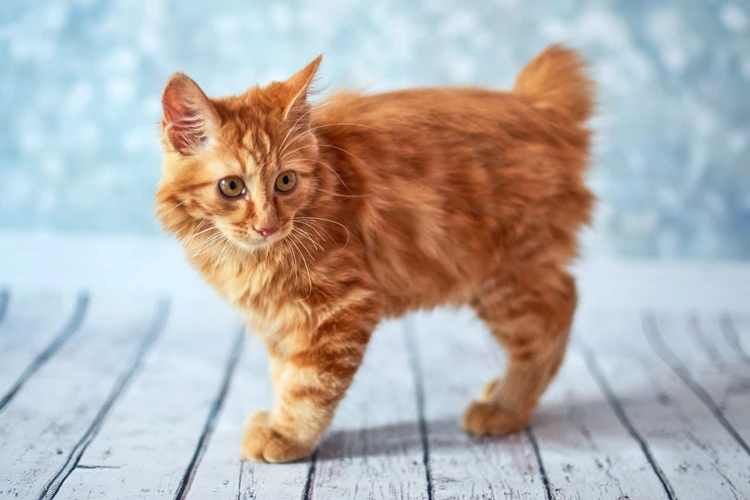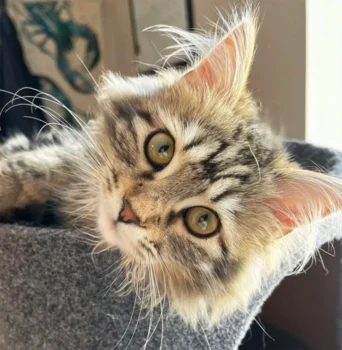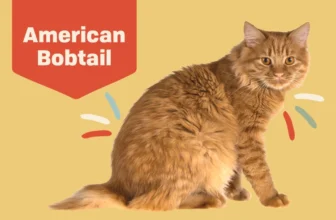It’s every pet parent’s worst nightmare – discovering their beloved furry friend displaying aggressive behavior. It can be especially concerning when it comes to American Bobtails, known for their independent nature and occasional bouts of assertiveness. As a responsible owner, it’s crucial to understand the root causes of aggression and know how to identify and address it in a timely manner. In this article, we will go over step-by-step instructions for recognizing and managing aggressive behavior in American Bobtails, as well as preventing it from developing in the first place. So, let’s dive in and learn how to provide the best possible care for our feline companions.
Understanding Your American Bobtail’s Behavior

As cat owners, it’s important to understand the behavior of our beloved pets in order to provide them with a healthy and happy life. This is especially true for American Bobtails, who are known for their unique personalities and charming quirks. Understanding your American Bobtail’s behavior can help you recognize when something is amiss and take the necessary steps to address the issue. From their normal behavior to common causes of aggression and the importance of socialization, this section will provide you with all the information you need to better understand your American Bobtail. For more information on socialization and its impact on American Bobtail behavior, be sure to check out our article on socialization and American Bobtails.
1.1 Normal American Bobtail Behavior
Strong, sturdy, and with a distinctive short tail, the American Bobtail is a breed of cat that is known for its friendly and playful personality. They are highly intelligent and exhibit many behaviors characteristic of their breed. Here are some of the typical behaviors that a well-socialized and happy American Bobtail might display:
- Playfulness: American Bobtails love to play and are often described as “dog-like” in their behavior. They enjoy chasing toys, playing fetch, and exploring their surroundings.
- Curiosity: These cats are very curious and love to investigate their environment. They may watch birds outside the window or paw at objects around the house.
- Affectionate: American Bobtails are known for being affectionate with their owners. They may follow you around the house, curl up on your lap, or rub against your leg for attention.
- Independence: Despite their affectionate nature, American Bobtails are also independent and self-sufficient. They don’t require constant attention and are happy to spend time alone.
- Talkativeness: Some American Bobtails can be quite talkative and will “meow” to communicate with their owners.
- Litter Box Trained: These cats are known for their cleanliness and are usually easily litter box trained, as long as the litter box is kept clean and accessible.
Understanding the normal behavior of American Bobtails is key to recognizing when something is wrong. If your American Bobtail is displaying abnormal behavior, it may be a sign of aggression or a medical issue. To learn more about how to interpret your American Bobtail’s behavior, check out our article on Understanding Body Language in American Bobtails.
1.2 Common Causes of Aggression
Aggression in American Bobtails can be triggered by various reasons. Knowing the common causes of aggression can help you identify the root cause and address the behavior accordingly. Below are some of the most common causes of aggression in American Bobtails, as well as some ways to prevent these triggers from happening:
| Cause of Aggression | Prevention Technique |
|---|---|
| Poor socialization as a kitten | Ensure proper socialization techniques as early as possible. You can learn more about bonding with your American Bobtail here. |
| Physical illness or pain | Ensure your American Bobtail is up-to-date on all medical check-ups, and take them to the vet if you notice any unusual changes in their behavior. |
| Territorial aggression | Ensure your American Bobtail has their personal space and territory within your home. Provide them with scratching posts to define their boundaries, and avoid introducing new pets to the household. |
| Lack of stimulation and playtime | Make sure your American Bobtail gets regular playtime and physical activity. Provide them with toys and other forms of stimulation to prevent boredom. |
| Genetics and personality traits | While genetics and personality traits play a role in an American Bobtail’s behavior, proper training and socialization can adjust these tendencies. Learn more about American Bobtail personality traits here. |
As you can see, there are various causes of aggression in American Bobtails, and each requires a different approach to address. By understanding the root cause of your cat’s aggression, you can take steps to prevent it from happening in the future.
1.3 The Importance of Early Socialization
Early socialization is crucial for your American Bobtail to build positive associations and develop a well-rounded personality. When your bobtail is exposed to different people, animals, environments, and experiences, they learn how to react appropriately, which ultimately reduces the likelihood of aggressive behavior.
Why Is Early Socialization Important?
Early socialization is important because it sets the foundation for your American Bobtail’s behavior and temperament. If they are not exposed to a variety of experiences, they may become fearful, anxious, or aggressive later in life. Socialization helps your cat develop strong emotional bonds and learn appropriate social behavior, which will make them happier and more confident in the long run.
When Should You Begin Socializing Your American Bobtail?
You should begin socializing your American Bobtail as soon as possible, ideally around the age of 2-3 weeks old. During this period, kittens are most receptive to new experiences, and their brains are actively developing. However, socialization should continue well into adulthood, particularly during the first year of life when the cat is still learning.
How Can You Socialize Your American Bobtail?
Socializing your American Bobtail can involve a variety of experiences, including introducing them to different people, animals, and environments. Here are some tips to help with the socialization process:
| Tip | Description |
|---|---|
| Introduce your cat to new people | Encourage your cat to meet new friends, family members, and acquaintances. Make sure to supervise the interactions and ensure that the person is gentle with your cat. |
| Expose your cat to new environments | Take your cat on car rides, walks, and outdoor adventures to expose them to different sights, sounds, and smells. This can help them become more comfortable in new places. |
| Expose your cat to new animals | It can be beneficial to introduce your cat to other pets in a safe and controlled environment. Make sure to supervise the interactions and ensure that your cat feels safe and comfortable. |
| Positive reinforcement | Use treats, toys, and praise to reward your cat for good behavior during socialization experiences. This will help them develop positive associations with new experiences and people. |
| Be patient | Socialization is a gradual process, and it takes time and patience to help your American Bobtail become comfortable in new situations. Do not force your cat into new experiences, as this can lead to fear and anxiety. |
The Bottom Line
Early socialization is essential for your American Bobtail’s emotional and behavioral development. By exposing your cat to new experiences and environments, you can reduce their likelihood of becoming aggressive and help them become happier and more confident in the long run. Remember to be patient, consistent, and positive during the socialization process, and always prioritize your cat’s safety and well-being.
Identifying Aggressive Behavior in Your American Bobtail

Being able to identify aggressive behavior in your American Bobtail is crucial to ensuring the safety of both your furry friend and anybody that comes into contact with them. While the occasional hiss or scratch is a natural part of feline behavior, certain signs can indicate a more significant problem. In this section, we will explore the physical, verbal, and behavioral signs of aggression in American Bobtails and what they may indicate. By being able to recognize these signs, you can address any issues early on and find ways to manage and prevent them in the future.
2.1 Physical Signs of Aggression
Recognizing physical signs of aggression in your American Bobtail is crucial in identifying problematic behaviors before they escalate to a dangerous level. Keep in mind that while some physical signs of aggression can be normal in certain scenarios, persistent or excessive displays are a cause for concern. The following table outlines common physical signs of aggression in American Bobtails:
| Physical Signs of Aggression | Description |
|---|---|
| Arched Back | An arched back is often accompanied by a fluffy tail and can signal that your American Bobtail is feeling threatened or defensive. |
| Fur Standing Up | A cat’s fur standing up is a visible indication of their emotional state. Raised fur signifies that your American Bobtail is agitated and potentially ready to attack. |
| Dilated Pupils | While dilated pupils can be a sign of excitement or interest, when combined with other physical signs of aggression, it can indicate that your American Bobtail is feeling threatened or preparing to attack. |
| Growling or Hissing | Growling or hissing is a vocal sign of aggression in cats. If your American Bobtail is growling or hissing, they may be feeling threatened or territorial. |
| Showing Teeth or Claws | When your American Bobtail shows their teeth or claws, it’s a clear sign that they’re ready to attack. This display is typically accompanied by flattened ears and a crouched stance. |
It’s essential to pay attention to your American Bobtail’s body language and physical signs of aggression. These signs can warn you that your cat is not feeling comfortable in their environment or that they need attention and training to prevent future aggressive behavior.
2.2 Verbal Signs of Aggression
Verbal signs of aggression in American Bobtails can be just as telling as physical signs. If your Bobtail is growling, hissing, or meowing in a deep and guttural way, it may be an indication of aggressive behavior. Take a look at the table below for a breakdown of verbal signs of aggression in American Bobtails.
| Verbal Signs of Aggression | Description |
|---|---|
| Hissing | Hissing is one of the most common verbal signs of aggression. It’s a warning that your Bobtail is feeling threatened and may be on the verge of an attack. |
| Growling | If your American Bobtail is growling, it could mean that they are angry or frightened. It’s a warning that they may lash out if they feel threatened. |
| Low-pitched meowing | A low-pitched meow can indicate that your Bobtail is in a state of agitation. They may be uncomfortable or feel threatened, which can lead to aggression. |
| Excessive meowing | If your American Bobtail is meowing excessively, it could be a sign that they are frustrated or seeking attention. This can lead to aggressive behavior if not addressed properly. |
| Guttural sounds | Guttural sounds, like deep growls or grunting, can indicate that your Bobtail is feeling threatened or is preparing for an attack. It’s important to address these sounds before they escalate into physical aggression. |
If your American Bobtail is exhibiting any of these verbal signs of aggression, it’s important to take note of the situation and address it as soon as possible. Ignoring these signs could lead to a physical attack, so it’s best to intervene early and address the root cause of the behavior. Remember to always approach your Bobtail with caution and respect their space when they are displaying aggressive behavior.
2.3 Behavioral Signs of Aggression
Behavioral signs of aggression in American Bobtails are an important indicator that your cat is not feeling comfortable in a specific situation. Recognizing these signs can help you intervene before things escalate. Some of the common behavioral signs of aggression in American Bobtails are:
| Behavioral Signs of Aggression | Description |
|---|---|
| Hissing or Growling | When your cat begins to hiss or growl, it is a clear indication that they are feeling threatened or uncomfortable. This behavior is not normal for a relaxed cat and should be taken seriously. |
| Excessive Licking or Grooming | Excessive grooming can be a sign that your American Bobtail is feeling anxious or stressed. This behavior is more common in cats that are experiencing aggression from other cats in the household. |
| Stiff Body Posture | A stiff body posture is a clear indication that your cat is not feeling comfortable. When American Bobtails are aggressive, they may puff up their fur and become very tense as they prepare to attack. This behavior should be taken as a warning sign. |
| Swishing Tail | A swishing tail is not always a sign of aggression, but it can be an indication that your cat is feeling agitated or frustrated. Pay attention to the speed and frequency of the tail movements to determine if it is a sign of aggression or not. |
| Backing Away or Hiding | If your American Bobtail is backing away or hiding, it is a clear sign that they are feeling threatened or uncomfortable. This behavior should not be ignored, as it can lead to more aggressive behavior if the cat feels they have no other options. |
It is important to keep in mind that each cat is different and may display unique behavioral signs of aggression. By paying attention to your American Bobtail’s body language and vocalizations, you can better understand their needs and intervene as necessary. It is always better to be proactive in addressing aggressive behavior to ensure the safety of both your cat and your household.
Managing and Addressing Aggressive Behavior in Your American Bobtail

Dealing with aggressive behavior in American Bobtails can be challenging and even scary for pet owners. However, it’s important to understand that aggression is a common behavior displayed by many cats and can often be managed and addressed with proper techniques. The key is to prioritize safety first and foremost and then identify and address the root cause of the behavior. This section will provide you with practical tips for managing and addressing your American Bobtail’s aggressive behavior in a safe and effective manner.
3.1 Safety First
When dealing with aggressive behavior in your American Bobtail, safety should always be your top priority. Here are some tips to ensure that you and your cat stay safe:
- Avoid physical confrontation: Do not attempt to physically restrain or punish your cat. This can escalate the situation and increase the risk of injury to both you and your cat.
- Create a safe space: Provide your cat with a safe and secure place where they can retreat to when they are feeling scared or stressed. This can be a separate room or a cozy corner with a comfortable bed and toys.
- Use protective gear: If you need to interact with your cat during aggressive episodes, consider wearing protective clothing and gloves to avoid scratches and bites.
- Stay alert: Be aware of your cat’s body language and behavior. Take note of their triggers and avoid situations that may cause aggressive outbursts.
- Keep children and other pets safe: If you have children or other pets in the house, make sure they are kept at a safe distance from your aggressive cat.
By prioritizing safety, you can help prevent injuries and create a more peaceful and comfortable environment for both you and your American Bobtail. Remember, aggressive behavior is not something to be taken lightly and it’s important to take the necessary precautions to ensure the safety of everyone involved.
3.2 Addressing the Root Cause
Identifying and addressing the root cause of your American Bobtail’s aggressive behavior is crucial for effectively managing and resolving the issue. Here are some steps you can take:
- Observe and assess their behavior: Look for patterns in your cat’s behavior to understand what triggers their aggression. Note the time of day, people, other animals or stimuli that may be related to their aggressive episodes. Keeping a log can help to identify common triggers.
- Minimize stressors: Once you identify the triggers, start working to minimize or avoid them as much as possible. For example, if your cat is aggressive towards other animals, you may need to limit or separate their interactions until they can be successfully reintroduced in a supervised setting.
- Address any underlying health issues: Aggressive behavior may stem from an underlying medical condition. If you suspect this could be the case, it’s important to consult your veterinarian. Health issues such as pain or discomfort may cause your cat to act out in an aggressive manner.
- Create a predictable routine: Make sure your cat has a consistent and predictable routine. This helps to reduce their stress and anxiety, which can often lead to aggressive behavior. This includes feeding them at regular intervals, providing them with a comfortable and safe space to retreat to, and maintaining a consistent play and sleep schedule.
- Use positive reinforcement: Training your American Bobtail using positive reinforcement helps to build their trust and confidence. Reward your cat when they behave positively, and ignore bad behavior instead of punishing them. Positive reinforcement can include treats, toys, and verbal praise.
By addressing the root cause of your American Bobtail’s aggressive behavior, you can help them feel safer and more secure, which can reduce their aggression. Remember that managing and resolving aggression takes time and patience, but with consistency and positive reinforcement, you can help your cat learn more appropriate and healthier ways to communicate their needs.
3.3 Training and Socialization Techniques
One effective method for addressing and managing aggressive behavior in American Bobtails is through training and socialization techniques. These techniques aim to teach your cat appropriate behavior and help them feel more comfortable and confident in various situations. Here are some key training and socialization techniques you can use:
| Technique | Description |
| Socialization with Other Cats | Regularly exposing your American Bobtail to other cats can help improve social skills and reduce aggressive behavior. Gradually introduce your cat to other cats and watch their body language for signs of discomfort or aggression. |
| Positive Reinforcement Training | Rewarding good behavior with treats, toys, or praise can be an effective way to teach your cat desired behaviors. For example, reward your cat for not showing aggression when interacting with other cats or when responding to your commands. |
| Clicker Training | Clicker training can help improve your cat’s focus and reduce anxiety. Use a clicker to signal to your cat when they have done something right and then follow up with a treat or praise. Over time, your cat will learn to associate the click with good behavior. |
| Desensitization | If your American Bobtail is aggressive toward a certain situation, such as a vet visit or grooming, you can use desensitization techniques to help them feel more comfortable. Gradually expose your cat to the situation in a controlled manner while rewarding them for remaining calm. |
| Redirected Aggression Training | If your cat displays aggression toward you, redirect their attention to a toy or other source of stimulation. This technique can help prevent your cat from attacking you and instead focus their attention on something appropriate. |
It is important to note that training and socialization should be done consistently and with patience. It may take some time for your American Bobtail to learn and adjust to new behaviors, but with dedication and persistence, you can help reduce their aggressive behavior and improve their overall quality of life.
3.4 Medical Causes and Treatment
It’s important to consider that aggressive behavior in American Bobtails can sometimes be the result of underlying medical issues. As a pet owner, it’s crucial to be aware of any potential medical causes and seek the proper treatment to help your furry friend feel better.
Some medical reasons that can cause aggressive behavior in American Bobtails include pain, illness, and injury. If your cat is experiencing any of these, they may become irritable, lash out, or act defensively.
Other possible medical causes include hormonal imbalances and brain disorders. In some cases, aggression may be a sign of hyperthyroidism or brain tumors.
Treating medical causes of aggression in American Bobtails typically involves a combination of medication, surgery, or other veterinary interventions. Your vet will need to perform a thorough examination to determine the root cause of the aggression and develop a treatment plan that addresses both the underlying issue and any behavioral problems that may result from it.
It’s important to note that not all aggressive behavior is the result of medical causes, and it’s essential to consider all potential causes when addressing aggressive behavior in your American Bobtail. If you suspect that your cat’s aggression might be due to a medical issue, it’s essential to seek veterinary care promptly to ensure that your cat is getting the care it needs.
Here’s a table summarizing the potential medical causes of aggressive behavior in American Bobtails and the associated treatment options:
| Medical Cause | Treatment |
|---|---|
| Pain, illness, or injury | Medication, surgery, or other veterinary interventions |
| Hormonal imbalances | Medication, surgery, or other veterinary interventions |
| Brain disorders | Medication, surgery, or other veterinary interventions |
3.5 When to Seek Professional Help
It can be difficult to know when it’s time to seek professional help for your American Bobtail’s aggressive behavior. However, it’s important to recognize that their behavior can escalate quickly and become dangerous for both you and your pet. Here are some signs that it may be time to seek help from a professional:
| Signs it’s time to seek professional help for your American Bobtail’s aggression |
|---|
| Frequent and intense attacks: If your American Bobtail is attacking others or exhibiting aggression frequently and intensely, it’s time to seek professional help. |
| Behavioral changes: Sudden and drastic changes in your American Bobtail’s behavior, such as increased aggression and territorialism, may indicate an underlying issue that needs to be addressed by a professional. |
| Physical harm: If your American Bobtail has caused physical harm to humans or other pets, seeking professional help is necessary to prevent further harm. |
| Aggression in response to stimuli: If your American Bobtail is exhibiting unprovoked aggression or aggression in response to everyday stimuli such as petting or handling, professional help is needed to address the root cause. |
| Lack of improvement: If you’ve tried various training and socialization techniques and haven’t seen any improvement in your American Bobtail’s aggressive behavior, it’s time to seek the help of a professional. |
Remember, seeking professional help is not a sign of failure, but rather a proactive step in ensuring the safety of both you and your American Bobtail. A professional can provide personalized guidance and treatment to address your cat’s aggressive behavior and improve their overall quality of life.
Preventing Aggressive Behavior in Your American Bobtail
As a responsible American Bobtail owner, you want to prevent any aggressive behavior from developing in your furry friend. Fortunately, there are steps you can take to ensure a happy and harmonious relationship with your pet. By implementing proper socialization, providing consistent training and positive reinforcement, and offering enough stimulation and entertainment, you can prevent your American Bobtail from becoming aggressive. Let’s explore these preventive measures in more detail.
4.1 Ensuring Proper Socialization
To prevent aggressive behavior in your American Bobtail, ensuring proper socialization from a young age is crucial. American Bobtails are intelligent and adaptable animals and they need to socialize with different people and pets to get comfortable with them. The below table outlines some strategies to ensure proper socialization:
| Strategy | Description |
| Expose to different people | Expose your American Bobtail to a variety of people with different ages, genders, and races. Every human behaves and interacts differently, so exposing them to many people will help them become familiar with human behavior and comfortable in different social situations. |
| Introduce to other animals | If you have other pets at home, introduce them to your American Bobtail slowly and under supervision. Your American Bobtail will develop a very different behavior understanding around different species, and can benefit from interacting with them from a young age. |
| Take to new places | Your American Bobtail should be taken on trips that include positive stimuli, including different scenery, sounds, and smells. This helps acclimate them to new situations, as well as familiarizing them with outdoor environments. |
| Positive reinforcement | Consistent training with positive reinforcement is key. When your cat behaves positively, reward him or her with a treat, praise, or petting. This will help your American Bobtail associate good behaviors with reward, reinforcing and maintaining good habits. |
By taking these steps to ensure proper socialization, you will provide your American Bobtail with the tools to feel comfortable around different people and pets, under different circumstances. This can prevent aggressive behavior toward humans and other animals, making life easier for both you and your pet.
4.2 Consistent Training and Positive Reinforcement
Consistent Training and Positive Reinforcement are crucial in preventing aggressive behavior in American Bobtails. Training your cat on basic commands like “sit,” “stay,” and “come” helps establish a bond between you and your pet, and creates predictability and structure in your cat’s daily life.
Positive Reinforcement is a highly effective training method that rewards desired behavior. Instead of punishing your cat for inappropriate behavior, it’s better to reward them for doing something right. Rewards can be in the form of treats, verbal praise, or playtime with toys. For example, if your cat uses their scratching post instead of your sofa, reward them with a treat or praise.
Using a clicker can also be a great way to reinforce positive behavior. A clicker is a small hand-held device that makes a clicking sound when pressed. When your cat performs a desired action, click the device and reward them with a treat. Over time, your cat will associate the sound of the clicker with a reward and respond to it positively.
Consistency is key when training your American Bobtail. Make sure that all family members and caretakers are on the same page with training techniques and commands to avoid confusion. Consistency helps establish a routine for your cat, which can reduce stress and anxiety and prevent aggressive behavior.
To make training sessions more effective, keep them short and frequent. Five minutes a day is plenty of time to work on basic commands and reinforce positive behavior. Over time, you can gradually increase the length and difficulty of the commands.
Here’s a table summarizing the key points of Consistent Training and Positive Reinforcement:
| Training Techniques | Benefits |
|---|---|
| Positive Reinforcement | Highly effective training method that rewards desired behavior |
| Clicker Training | Teaches your cat to associate the sound of a clicker with a reward |
| Consistency | Establishes a routine for your cat and reduces stress and anxiety |
| Short, Frequent Sessions | Effective way to work on basic commands and reinforce positive behavior |
By consistently training your American Bobtail using positive reinforcement, you can establish a strong bond and prevent aggressive behavior. Remember to keep training sessions short, frequent, and consistent, and use rewards to reinforce desired behavior. With time and patience, your furry friend can become the well-behaved companion you’ve always wanted.
4.3 Providing Enough Stimulation and Entertainment
One of the ways to prevent aggressive behavior in your American Bobtail is by providing enough stimulation and entertainment. This breed is known for being playful and active, so it’s important to meet their physical and mental needs. When a Bobtail doesn’t get enough stimulation or exercise, they may become bored and develop unwanted behaviors, such as aggression.
Physical Exercise: American Bobtails love to play and explore, and providing them with toys and climbing structures can help them stay active and healthy. Consider investing in cat trees, scratching posts, or interactive toys to keep them entertained. You may also want to set aside time each day to play with your Bobtail, such as using a laser pointer or playing with a feather toy.
Mental Stimulation: In addition to physical exercise, American Bobtails also need mental stimulation. Puzzle toys and games can help keep their minds active and prevent boredom. Consider hiding treats throughout your home or using food puzzles to keep your Bobtail mentally stimulated. Additionally, providing them with a view of the outdoors or a bird feeder to watch can also provide mental stimulation.
Environmental Enrichment: American Bobtails need a stimulating environment to keep them happy and healthy. Consider allowing them to explore different rooms in your home, as well as providing them with safe access to outdoor spaces. You may also want to rotate their toys and scratching posts to keep their environment varied and interesting. Additionally, providing them with a comfortable and private space to relax and retreat to can help reduce stress and prevent aggression.
By providing your American Bobtail with enough physical exercise, mental stimulation, and environmental enrichment, you can help prevent aggressive behavior and ensure their overall health and happiness.
Conclusion
In conclusion, understanding and managing aggressive behavior in your American Bobtail is crucial for both your safety and your cat’s well-being. It’s important to remember that aggressive behavior is often a sign that something is wrong and may require professional attention.
By taking a proactive approach, you can address the root causes of aggressive behavior and prevent it from occurring in the first place. This involves providing adequate socialization, training, and stimulation for your cat, as well as seeking professional help if your cat’s aggressive behavior is severe or persistent.
Remember to always put safety first when dealing with aggressive behavior. This may involve seeking the help of a professional trainer or veterinarian and taking necessary safety precautions such as using a carrier or muzzling your cat during vet visits.
With patience, consistency, and proper care, you can prevent and manage aggressive behavior in your American Bobtail, creating a happy and healthy bond between you and your feline companion.
Frequently Asked Questions
1. Can American Bobtails be aggressive towards humans?
Yes, American Bobtails can exhibit aggressive behavior towards humans if they feel threatened or provoked.
2. What are the common reasons for American Bobtail aggression?
Common reasons for American Bobtail aggression include fear, territorial behavior, dominance, and redirected aggression.
3. Can aggressive behavior in American Bobtails be prevented?
Yes, aggressive behavior in American Bobtails can be prevented through early socialization, consistent training, and providing enough stimulation and entertainment.
4. Is it normal for American Bobtails to exhibit playful aggression?
Yes, it is normal for American Bobtails to exhibit playful aggression during playtime, but it should not be mistaken for real aggression.
5. What should I do if my American Bobtail exhibits aggressive behavior towards me?
If your American Bobtail exhibits aggressive behavior towards you, you should prioritize your safety and seek professional help if needed.
6. Can medical issues cause aggressive behavior in American Bobtails?
Yes, medical issues such as pain or illness can cause aggressive behavior in American Bobtails. It is important to rule out any medical causes before addressing the behavior.
7. Can neutering or spaying my American Bobtail help prevent aggression?
Yes, neutering or spaying your American Bobtail can help prevent aggression caused by hormonal behavior, but it should be done early in their life.
8. What is redirected aggression in American Bobtails?
Redirected aggression in American Bobtails is when they are unable to direct their aggression towards the target and instead direct it towards another person or animal.
9. What are the signs that an American Bobtail is about to become aggressive?
Signs that an American Bobtail is about to become aggressive include hissing, growling, dilated pupils, flattened ears, and a low posture.
10. Is punishment an effective way to address aggressive behavior in American Bobtails?
No, punishment is not an effective way to address aggressive behavior in American Bobtails. Positive reinforcement and consistent training are much more effective methods.







